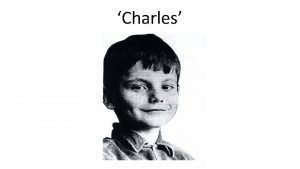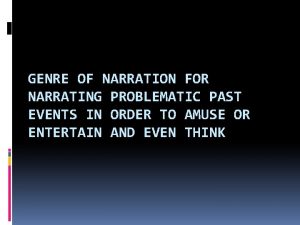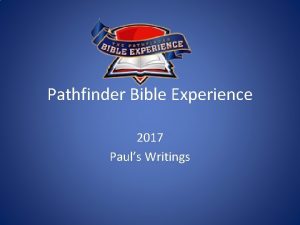Narrating Trauma in the Writings of Sam Watkins









- Slides: 9

Narrating Trauma in the Writings of Sam Watkins and Ambrose Bierce John Casey University of Illinois at Chicago NEMLA 2013 Boston, MA

Review of Existing Trauma Theory “The wound of the mind is not, like the wound of the body, a simple and healable event, but rather an event that is experienced too soon, too unexpectedly, to be fully known and is therefore not available to consciousness until it imposes itself again, repeatedly, in the nightmares and repetitive actions of the survivor” (Caruth, 4).

Review of Existing Trauma Theory (cont. ) “I am dismayed by the low quality of van der Kolk’s scientific work. Again and again, as I tried to show, there are slippages and inconsistencies in his arguments about the literal nature of traumatic memory, arguments that are inadequately supported by the empirical evidence he adduces. It is all the more necessary to insist on this because humanists tend to take his claims to scientific accuracy at face value” (Leys, 305).

Trauma, Narrative, and the Civil War (Cont. ) Sam Watkins • “Y’s You Got my Hog” (1882) • “The Death of Lieutenant John Whitaker” (1882) All of the sketches in Company Aytch originally appeared in the Columbia (TN) Herald during 1881 and 1882. They were published in book form in 1882 by the Presbyterian Publishing House of Nashville, TN. Ambrose Bierce • “One of the Missing” (1888, 1891). First published in the San Francisco Examiner in 1888. Later republished in the short story collection Tales of Soldiers and Civilians in 1891. • “A Resumed Identity” (1908). First published in Cosmopolitan magazine as “The Man” in 1908. Later included in Bierce’s posthumous collected works.

Trauma, Narrative, and the Civil War (Cont. ) Exhibit A: Narrative Tone and a Crisis of Form “Y’s You Got My Hog? ” “I was in a bad fix. I had hear the gun fire and knew its portent. I knew the hog was dead, and went on up the road, and soon overtook my two comrades with the hog, which had been skinned and cut up, and was being carried on a pole between them. I did not know what to do. On looking back I saw the old lady coming and screaming at the top of her voice, ‘You got my hog!’ It was too late to back out now. We had the hog, and had to make the most of it, even if we did ruin a needy and destitute family” (Watkins, 108 -09).

Trauma, Narrative, and the Civil War (Cont. ) Exhibit A: Narrative Tone and a Crisis of Form “Death of Lieutenant John Whitaker” “The day will come when the good as well as evil will all meet on one broad platform, to be rewarded for the deeds done in the body, when time shall end, with the gates of eternity closed, and the key fastened to the girdle of God forever. Pardon me, reader, I have wandered. But when my mind reverts to those scenes and times, I seem to live in another age and time, and I sometimes think that ‘after us comes the end of the universe” (Watkins, 181).

Trauma, Narrative, and the Civil War (Cont. ) Exhibit B: The Relationship of Time and Identity “One of the Missing” “No thoughts of home, of wife and children, of country, of glory. The whole record of memory was effaced. The world had passed away—not a vestige remained. Here in this confusion of timbers and boards is the sole universe. Here is immortality in time—each pain an everlasting life. The throbs tick off eternities” (Bierce, 244).

Trauma, Narrative, and the Civil War (Cont. ) Exhibit B: The Relationship of Time and Identity “A Resumed Identity” “I was struck by a bullet and have been unconscious. It must have been a light, glancing blow: I find no blood and feel no pain. I will not trouble you for treatment, but will you kindly direct me to my command—to any part of the Federal army—if you know? ” Again the doctor did not immediately reply: he was recalling much that is recorded in the books of his profession—something about lost identity and the effect of familiar scenes in restoring it” (Bierce, 306).

Conclusion • Narrative technique of Bierce and Watkins further proof that literary modernism began earlier in the United States than WWI. • The relationship between narrative and trauma demonstrated by each author suggests a potential way out of the impasse currently faced by literary trauma theory. • “Traumatic events shake and break our understanding of what the world means, and resolving trauma is about learning to integrate the traumatic memories into the world view” (Hunt, 199)
 Why did laurie create the imaginary boy charles?
Why did laurie create the imaginary boy charles? Narration of past events
Narration of past events Refers to writings in which expression and form
Refers to writings in which expression and form Which title best completes this graphic organizer? *
Which title best completes this graphic organizer? * Informal vs formal writing examples
Informal vs formal writing examples Intertestamental writings
Intertestamental writings Watkins and son v carrig
Watkins and son v carrig Watkins creek franklin tn
Watkins creek franklin tn Sherron watkins
Sherron watkins Abraham watkins
Abraham watkins

















